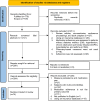Suitability of Measures of Pharmacy-Based Medication Adherence for Routine Clinical Use Among Patients with Chronic Diseases: A Systematic Review
- PMID: 39901904
- PMCID: PMC11789522
- DOI: 10.2147/PPA.S492461
Suitability of Measures of Pharmacy-Based Medication Adherence for Routine Clinical Use Among Patients with Chronic Diseases: A Systematic Review
Abstract
Purpose: To identify the suitability of pharmacy-based measures for determining medication adherence in routine clinical use.
Methods: Data were obtained through PubMed and Scopus databases up to December 2023 without publication year restrictions. This review included English studies on assessing medication adherence for hypertension, hyperlipidemia, asthma, chronic obstructive pulmonary disease, and diabetes, using pharmacy databases and providing full-text access. We investigated evidence quality utilizing the Newcastle-Ottawa Scale for non-randomized studies (cohort, case-control, and cross-sectional) and the Risk of Bias Assessment Tool for Non-randomized Studies-2 and JADAD scales for quasi-experiments and randomized control trials, respectively. We determined validity characteristics (completeness, accuracy, reliability, objectivity, continuous adherence history, non-intrusiveness, sensitivity, and specificity) and applicability (cost-effectiveness, ease of use, and interpretability) to evaluate the suitability of pharmacy-based medication adherence measures in clinical settings.
Results: This review retrieved 1513 studies, of which 74 met the inclusion criteria. All of the studies, which were published from 2000 to 2023 and mostly utilized a retrospective cohort design (n = 53), included 17.6 million patients. Of the 74 studies, 50 were conducted in the United States. Diabetes mellitus (n = 40) was the most prevalent disease, whereas the medication possession ratio (n = 46) and prescription days covered (n = 31) were the most prevalent pharmacy-based matrix. According to the results, 73 articles demonstrated validity characteristics, whereas 1 article lacked these characteristics. All 74 (100%) articles had applicability characteristics.
Conclusion: This systematic review demonstrates that pharmacy-based measures possess valid characteristics, including comprehensive, accurate, objective, reliable, and continuously updated adherence history records. These measures are designed to minimize disruption while offering high sensitivity and specificity. Furthermore, they are characterized by their practicality, being cost-effective, easy to implement, and easy to interpret. These findings suggest that pharmacy-based measures are potentially suitable to assess medication adherence for routine clinical use.
Keywords: applicability; chronic disease; medication adherence; medication possession ratio; pharmacy fill; proportion of days covered; routine clinical use; suitability; validity.
© 2025 Jannah et al.
Conflict of interest statement
The authors declare no conflicts of interest in this work.
Figures
Similar articles
-
Medication (re)fill adherence measures derived from pharmacy claims data in older Americans: a review of the literature.Drugs Aging. 2013 Jun;30(6):383-99. doi: 10.1007/s40266-013-0074-z. Drugs Aging. 2013. PMID: 23553512 Review.
-
Validity of the adherence estimator in the prediction of 9-month persistence with medications prescribed for chronic diseases: a prospective analysis of data from pharmacy claims.Clin Ther. 2009 Nov;31(11):2584-607. doi: 10.1016/j.clinthera.2009.11.030. Clin Ther. 2009. PMID: 20110004
-
Measurement of adherence in pharmacy administrative databases: a proposal for standard definitions and preferred measures.Ann Pharmacother. 2006 Jul-Aug;40(7-8):1280-88. doi: 10.1345/aph.1H018. Ann Pharmacother. 2006. PMID: 16868217
-
Exploring the Agreement Between Self-Reported Medication Adherence and Pharmacy Refill-Based Measures in Patients with Kidney Disease.Patient Prefer Adherence. 2022 Dec 30;16:3465-3477. doi: 10.2147/PPA.S388060. eCollection 2022. Patient Prefer Adherence. 2022. PMID: 36605331 Free PMC article.
-
Pharmacy-based management for depression in adults.Cochrane Database Syst Rev. 2019 Dec 23;12(12):CD013299. doi: 10.1002/14651858.CD013299.pub2. Cochrane Database Syst Rev. 2019. PMID: 31868236 Free PMC article.
References
-
- WHO.Action Plan for the Prevention and Control of Noncommunicable Diseases in South-East Asia, 2013–2020. World Health Organization, Regional Office for South-East Asia; 2021. http://apps.who.int/bookorders.
-
- WHO. Noncommunicable Diseases. N Engl J Med. 2013;11:9345. doi:10.1056/nejmra1109345 - DOI
-
- WHO. Hypertension. 2023. Accessed November 16, 2023. Available from: https://www.who.int/news-room/fact-sheets/detail/hypertension.
-
- World Health Organization. Asthma. 2023. Accessed Nov 16, 2023. Available from: https://www.who.int/news-room/fact-sheets/detail/asthma#:~:text.
-
- WHO. The top 10 causes of death. 2020. Accessed November 16, 2023. Available from: http://www.who.int/news-room/fact-sheets/detail/the-top-10-causes-of-dea....
Publication types
LinkOut - more resources
Full Text Sources
Miscellaneous


